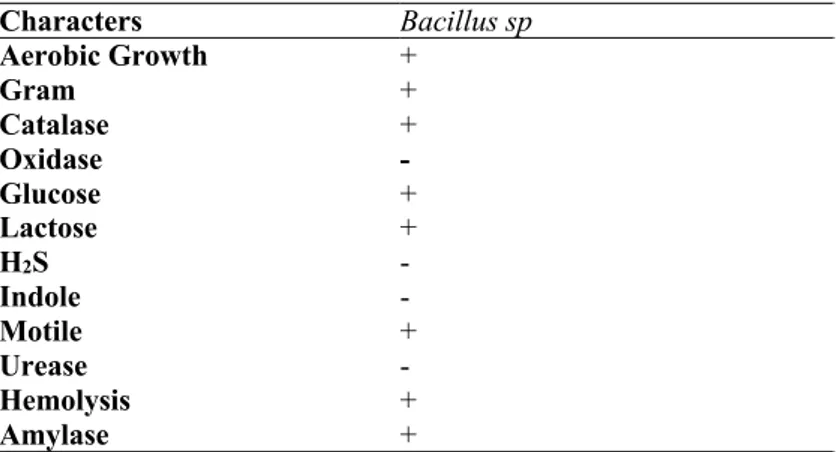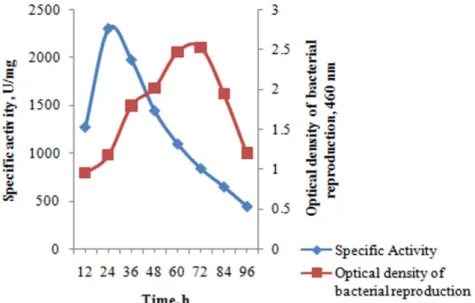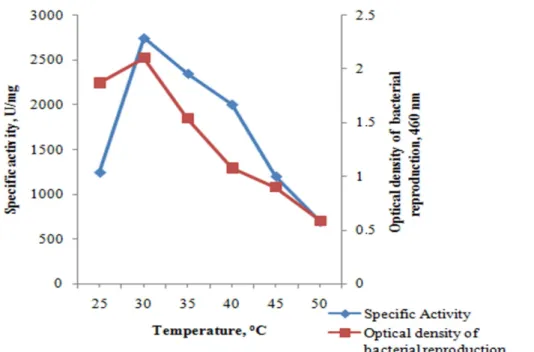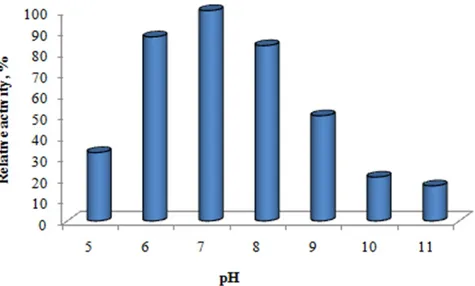Isolation and Identification of Bacillus sp. from Root Soil of the Astragalus
gummifer Lab.: Obtaining and Characterization of α-Amylase
Barış ENEZ1,*
1Bingöl University, Vocational School of Technical Science, Veterinary Health Department, Bingöl,
Turkey
benez@bingol.edu.tr, ORCID: 0000-00003-4730-3458
Received: 27.01.2020 Accepted: 03.03.2020 Published: 25.06.2020
Abstract
α-Amylase (1,4-α D-glucanohydrolase; EC 3.2.1.1) is one of the enzymes that can be used in a number of industrial processes such as bakery, textile, paper, detergents, and is the most important industrial product that plays an important role in the production of bioprotein and the fermentation of starch. The present research aims to the information gap in this area by performing bacterial isolation from the root of Astragalus gummifer. Bacterial isolation was performed using serial dilution technique. 16S rRNA analysis was performed for species identification of the microorganism. Isolated microorganism was determined to be gram (+), moving as a result of biochemical tests. Biochemical tests; Catalase, hemolysis, glucose and lactose tests positive (+); indole, H2S and urease tests showed negative (-) results. Soil samples were analyzed by ICP-MS.
As a result of the analysis, it was determined that Al, Cr, Cu, Co, Fe, Pb, Mn and Zn were found in excess amount in the isolated bacteria. The optimal reproductive function of the bacteria was determined at 72 hours, 30 oC and pH 7.0. The maximum production time of α-amylase from
Bacillus sp. was 24 hours, 30 oC and pH 7.0. Bacteria identified and found to produce amylase
were determined to be used in different biotechnological areas.
Astragalus gummifer 'in Kök Topraktan Bacillus sp.’nin İzolasyonu ve Tanımlanması:
α-Amilazın Elde Edilmesi ve Karakterizasyonu Öz
α-Amilaz (1,4-α D-glukanohidrolaz; EC 3.2.1.1) fırıncılık, tekstil, kağıt ve deterjanlar gibi bir dizi endüstriyel işlemde kullanılabilen enzimlerden biridir ve en önemli endüstriyel üründür. Biyoprotein üretiminde ve nişastanın fermantasyonunda önemli rol oynar. Bu araştırmada, literatürde yeterli olmayan Astragalus gummifer bitkisinin kökünden bakteri izolasyon yapılarak bu alandaki eksiklik giderildi. Bakteriyel izolasyon seyreltme tekniği kullanılarak yapıldı. Mikroorganizmanın tür tanımlaması için 16 S rRNA analizi yapılmıştır. İzole edilen mikroorganizmanın biyokimyasal testler sonucunda gram (+) ve hareketli olduğu belirlenmiştir. Biyokimyasal testler; Katalaz, hemoliz, glikoz ve laktoz testleri pozitif (+); indol, H2S ve üreaz
testleri negatif (-) sonuçlar göstermiştir. Toprak örnekleri ICP-MS ile analiz edilmiştir. Analizler sonucunda izole edilmiş bakterinin bulunduğu toprakta Al, Cr, Cu, Co, Fe, Pb, Mn ve Zn'nun fazla miktarda olduğu tespit edildi. Bakterilerin optimal üreme koşulları 72 saat, 30 ºC ve pH
7.0'da olarak belirlenmiştir. Bacillus sp'den maksimum α-amilaz üretim süresi 24 saat, 30 ºC ve
pH 7.0 idi. Amilaz ürettiği tespit edilen bakterinin farklı biyoteknolojik alanlarda kullanılabileceği görüldü.
Anahtar Kelimeler: Bacillus sp.; α-Amilaz; Astragalus; Tanımlama; Optimizasyon.
1. Introduction
Alpha amylase (E.C 3.2.1.1) catalyzes the hydrolysis of α-D-(1,4) glycosidic connections in starch components and related carbohydrates [1]. It has a wide range of applications in the fields of starch liquefaction, paper, extraction of textile fabrics, preparation of starch coatings of paints, removal of wallpaper, beer industry, sugar syrup production and sugar induction and pharmaceutical [2-5]. Amylases are produced by plant, animal and microbial sources. When the origins compared; amylases from animal and plant origins are acidic, basic and have low resistance under high temperature conditions. Besides, bacterial and fungal amylases have good stability under these conditions and perform more economical production processes. Therefore; microbial enzymes have been applied in numerous biotechnological areas [6]. This is due to the characteristics of microbial amylases such as bulk production and easy genetic manipulation [7]. Microorganisms play an important role in the production of many industrially important enzymes that play a key role in hydrolyzing complex molecules [8, 9]. Amylase is the first industrially produced enzyme, although some enzymes are produced from microorganisms.
Among extracellular hydrolytic enzymes, amylases have a special status due to their high industrial value and cover about 30% of the enzyme market [10, 11]. Since almost all microorganisms of the genus Bacillus synthesize α-amylase, this genus has the potential for bacteria to dominate the enzyme industry [12]. The amylase production of Bacillus species varies greatly depending on the composition of moderate and other physical parameters. There is a need to increase amylase production without affecting the overall cost of production [13].
In the present research, bacteria isolation was performed by taking samples from the root soil of Astragalus gummifer plant, which is applied in many areas and has an important place especially in medical field. After isolation, bacterial species identification and biochemical tests were performed. Important parameters such as time, temperature and pH were studied to determine the optimal production conditions of the bacteria. Characterization was carried out to obtain maximum α-amylase from the bacterium, which was found to produce α-amylase of industrial importance.
2. Materials and Methods
2.1. Obtaining of biological material
Samples were taken from the root soil of the Astragalus gummifer plant found in Karlıova Region of Bingöl at July 2019. Plant sample identified by plant a taxonomist Dr. Ömer KILIÇ. The bacteria that used in the study were obtained from the plant sample.
2.2. Bacterial isolation
In order to obtain microorganism from soil, 1 g sample was taken and 9 ml sterile water was left on it. In this way, 10-1 suspension was made. Similarly, 10-2, 10-3, 10-4, 10-5, 10-6, 10-7
dilutions were obtained by successive transfers. In order to obtain a single colony, serial dilution samples were smeared on Nutrient Agar (NA) medium and incubated for 1 night at 37ºC.
2.3. Identification of microorganisms and biochemical tests
Biochemical tests were performed to identify selected bacterial sample. As biochemical test; Gram staining, hemolysis, mobility, catalase, amylase, coagulose, and urease tests were performed separately on the bacteria. In addition, 16S rRNA sequence analysis of the isolate was performed by Epi-Gen Biotechnology. The supernatant was used to measure amylase activity. Bacterial growth in the spectrophotometer was measured as 460 nm
Enzyme activity was performed according to DNS (Dinitrosalicylic acid) method. Bernfeld was used as a method to dissolve in 0.1 M Tris-HCl buffer pH 7.0 for 30 minutes at 37ºC using 0.5% starch as defined. One unit of amylase activity was defined as the amount of enzyme that releases reducing end groups of 1 µmol per minute at 37 ° C [14].
2.5. Protein quantity determination
Protein quantification was performed according to the Lowry method [15]. 2.6. Determination of metals in soil
The contents of the soil sample taken for isolation were carried out by ICP-MS.
2.7. Effect of temperature, time and pH on microorganisms and enzyme production The effects of time, pH and temperature parameters on bacterial growth were evaluated to determine the effect of incubation time 12 - 96. samples were analyzed at 460 nm spectrophotometer.
Temperature parameter, which has a significant effect on development, was examined. For this purpose, bacteria were produced at 25-50 ºC intervals and optimum temperature was determined. In order to determine the effect of pH on microorganism growth, optimum bacterial growth was determined between pH 4.0-10.
Time, pH and temperature effects were investigated to determine the maximum α-amylase production. Enzyme activity was determined from the samples taken for each parameter. After the analysis, spectrophotometry was also measured, and the specific activity was calculated.
2.8. Effect of temperature and pH on α-amylase activity
Maximum enzyme activity temperature and pH parameters were studied. 30-50 ºC to 5 ºC temperature values were studied in increments. Enzyme pH at different pHs between 4.0 and 11.0 were studied. Analysis was performed at 489 nm.
3. Results
3.1. Identification of microorganisms and biochemical tests
Biochemical test results showed that the bacteria were gram (+), bacillus and motile. Catalase, hemolysis, glucose and lactose were found to be positive; Biochemical tests such as
oxidase, H2S and indole were found to be negative. Detailed results of biochemical tests are given
in Table 1.
Table 1: Morphological and biochemical tests of microorganisms Characters Bacillus sp Aerobic Growth + Gram + Catalase + Oxidase - Glucose + Lactose + H2S - Indole - Motile + Urease - Hemolysis + Amylase + Positive:+, Negative:-
16S rRNA analysis was performed to identify single colony-reduced bacteria by dilution technique. As a result of the analysis, it was determined that the bacterium was Bacillus sp having 1451 bases. Below is the sequence analysis of the bacteria and the phylogenetic tree drawing
CCTTTTCGGCGGCTGGCTCCATAAAGGTTACCTCACCGACTTCGGGTGTTACA AACTCTCGTGGTGTGACGGGCGGTGTGTACAAGGCCCGGGAACGTATTCACCGCGG CATGCTGATCCGCGATTACTAGCGATTCCAGCTTCACGCAGTCGAGTTGCAGACTG CGATCCGAACTGAGAACAGATTTGTGGGATTGGCTTAACCTCGCGGTTTCGCTGCC CTTTGTTCTGTCCATTGTAGCACGTGTGTAGCCCAGGTCATAAGGGGCATGATGATT TGACGTCATCCCCACCTTCCTCCGGTTTGTCACCGGCAGTCACCTTAGAGTGCCCAA CTGAATGCTGGCAAC…
3.2. Analysis of sampled soil with ICP-MS
As a result of the analysis, it was determined that the amount of Al, Co, Cr, Cu, Fe, Pb, Mn and Zn in the ppb (mg L-1) level was very low and Ag and Se were less in the soil
Table 2: Soil analysis results
Elements Values (ppb, mg L-1) Al 14652251 Mn 694114.2 Pb 10053.51 Co 14368.29 Cr 56887.82 Cu 28130.29 Fe 20211887 Zn 37212.81 Se 917.1169
3.3. Effect of temperature, time and pH on microorganism and enzyme production When the incubation time was examined on microorganism development and enzyme production, it was determined that enzyme production and bacterial growth increased after 12 hours. Bacterial growth was increased depending on the duration of the most reproduction was determined at 72 hours. After this period, bacterial growth was decreased. As shown in Fig. 2, although the bacterial growth was maximum at 72 hours, α-amylase production was found to be highest at 24 hours. A decrease in α-amylase production was observed after 24 hours
Fermentation temperature and pH are also important parameters that clearly affect enzyme production. To determine the effect of temperature on bacterial growth and enzyme production, was carried out at 25-50 ºC.
Bacterial production increased from 25 ºC and maximum growth was observed at 30 ºC. It was determined that the growth decreased due to increasing temperatures. 50 ºC at the end of the reproduction was determined. When the amylase production is considered, it was observed that the maximum activity was at 30 ºC, as shown in Fig. 3, the specific activity decreases due to the increasing temperature. One unit of amylase activity was defined as the amount of enzyme that releases reducing end groups of 1 µmol per minute at 37 ºC
Figure 3: Effect of temperature on bacterial growth and enzyme production
Another important parameter that affects microorganism growth and enzyme production is pH. Bacterial growth was found to be between pH 5.0-10.0. The maximum reproduction pH was determined to be 7.0. At the end of the production, amylase production in pH range of 6.0-8.0 was determined. Maximum production was determined at pH 7.0
Figure 4: Effect of pH on bacterial growth and enzyme production 3.4. Effect of temperature and pH on enzyme activity
The effect of temperature on enzyme activity was investigated. For this purpose, different temperature media were used during the incubation times in the activity experiment. Thus, at which temperature the enzyme showed more activity was determined. As shown in Fig. 5, the enzyme activity was found to be high between 30-50 °C. Maximum enzyme activity was determined at 45 °C. Enzyme activity decreased due to increasing temperature 50 °C enzyme activity was determined to be 94%.
The effect of α-amylase on enzyme activity at pH 4.0-11 was investigated. The pH parameter has a significant effect on activity. As a result of the research, the maximum activity of the microorganism at neutral pH (pH 7.0) was determined. Fig. 6 provides detailed data on the effect of pH.
Figure 6: Effect of pH on amylase activity 4. Discussion
When the results of the research were examined, it was found that some researchers had more beneficial results than the results of this study.
For Bacillus atrophaeus Enez [16] found that the optimum bacterial production was at 72 hours, 30 ºC and pH 6.0; and the amylase production was at 36 hours, 35 ºC and pH 6.0. Hamilton et al. [17] found that the optimal incubation time from IMD 43 was 41 hours when and the temperature was 40 ºC. According to Asgher et al. [18] for the Bacillus subtilis obtained from JS-2004 amylase optimum conditions were found to be at 48 hours at 50 °C and pH 7.0. Bacillus sp. they carried out amylase production from EU 04. Behal et al. [19] determined optimal conditions of production at 36 hours and 40 °C, respectively. Saxena et al. [20] determined the optimum amylase production for Bacillus sp. that was obtained from PN5 for 60 hours at 60 °C and pH 7.0. Ozdemir et al [21] produced Bacillus mojavensis microorganism at 35°C, pH 7.0 and 36 hours for use in biotechnological studies. In their studies on Bacillus atrophaeus NRC1, Abd-Elaziz et al. [22] determined the production conditions of the bacteria as pH 6.0, 40 °C and 24 hours.
Although they show activity over a wide temperature range, the activity of amylase from many Bacillus species has been observed at 40 °C [3, 23]. Aguloğlu et al. [24] stated that the
maximum amylase activity of Geobacillus stearotermophilus bacteria was pH7.0. Wang et al. [25] determined the maximum temperature of the amylase obtained from Rhizomucor miehei as 75 °C and pH as 6.0.
5. Conclusions
Bacillus species found in soil flora are of great importance. Detection of these
microorganisms and their use in different biotechnology fields is important. Since enzyme technology has developed, studies on industrial enzymes have become more important. Therefore, amylase which has a great industrial importance was simply produced in the present study. In addition, economic processes and optimum conditions were determined and for the production.
References
[1] Gangadharan, D., Sivaramakrishnan S., Nampoothiri, K.M., Sukumaran, R.K., Pandey, A., Response surface methodology for the optimization of alpha amylase production by Bacillus
amyloliquefaciens, Bioresource Technology, 99, 4597–4602, 2008.
[2] Lévêque, E., Janeček, Š., Haye, B., Belarbi, A., Thermophilic archaeal amylolytic
enzymes, Enzyme and Microbial Technology, 26, 3–14, 2000.
[3] Ashwini, K., Gaurav, K., Karthik, L., Bhaskara Rao, K.V., Optimization, production
and partial purification of extracellular α-amylase from Bacillus sp. Marini, Archives of Applied
Science Research, 3, 33–42, 2011.
[4] Vijayalakshmi, K., Sushma, S.A., Chander, P., Isolation and characterization of
Bacillus subtilis KC3 for amylolytic activity, International Journal of Bioscience Biochemistry
and Bioinformatics, 2, 33, 2012.
[5] Sanchez, A.C., Ravanal, M.C., Andrews, B.A., Asenjo, J.A., Heterologous expression
and biochemical characterization of a novel cold active α-amylase from the Antarctic bacteria Pseudoalteromonas sp. 2-3, Protein Expression and Purification, 155, 78–85, 2019.
[6] Elmansy, E.A., Asker, M.S., El-Kady, E.M., Hassanein, S.M., El-Beih, F.M.,
Production and optimization of α-amylase from thermo-halophilic bacteria isolated from different local marine environments, Bulletin of the National Research Centre, 42, 31, 2018.
[7] Souza, P.M., Magalhaes, P.O., Applications of microbial α-amylase in industry-a
review, Brazilian Journal of Microbiology, 41, 850–61, 2010.
[8] Pandey, A., Nigam, P., Soccol, C.R., Socco, V.T., Singh, D., Mohan, R., Advances in
microbial amylases, Biotechnology and Applied Biochemistry, 31, 135–52, 2000.
[9] Lipson, D.A., Schadt, C.W., Schmidt, S.K., Changes in Soil Microbial Community
Structure and Function in an Alpine Dry Meadow Following Spring Snow Melt, Microbial
Ecology, 43, 307–314, 2002.
[10] Panneerselvam, T., Elavarasi, S., Isolation of α-Amylase Producing Bacillus subtilis
from Soil, International Journal of Current Microbiology and Applied, 4: 543–552, 2015.
[11] Schallmey, M., Singh, A., Ward, O.P., Developments in the use of Bacillus species for
[12] Božić, N., Ruiz, J., Santίn, J.L., Vujćić, Z., Production and properties of the highly
efficient raw starch digesting α-amylase from a Bacillus licheniformis ATCC 9945a, Biochemical
Engineering Journal, 53, 203–209, 2011.
[13] Pranay, K., Padmadeo, S.R., Jha, V., Prasad, B., Screening and identification of
amylase producing strains of Bacillus, Journal of Applied Biology Biotechnology, 1–6, 2019.
[14] Bernfeld, P., Enzymes carbohydrate metabolism, ln Methods ln Enzymology, Academic Press, 17: 149–158, 1955.
[15] Lowry, O.H., Roserbrough, N.J., Farr, A.L., Randall, R., Protein measure ment with
folin phenol reagent, Journal of Biological Chemistry, 193, 265–275, 1951.
[16] Enez, B., Işgının Kök Toprağından Bacillus atrophaeus’un İzolasyonu ve
Tanımlanması: α-Amilaz’ın Elde Edilmesi ve Karakterizasyonu, European Journal of Science and
Technology, 177, 36–743, 2019.
[17] Hamilton, L.M., Kelly, C.T., Fogarty, W.M., Production and properties of the raw
starch digesting α-amylase of Bacillus sp. IMD 435, Process Biochemistry, 35, 27–31, 1999.
[18] Asgher, M., Asad, M.J., Rahman, S.U., Legge, R.L., A thermostable α-amylase from
a moderately thermophilic Bacillus subtilis strain for starch processing, Journal of Food
Engineering, 79, 950–955, 2007.
[19] Behal, A., Sharma, M.K., Puri, P., Singh, J., Batra, N., Characterization of alkaline
α-amylase from Bacillus sp. AB 04, International Journal of Agriculture and Biology, 8, 80–83,
2006.
[20] Saxena, R.K., Dutt, K., Agarwal, L., Nayyar, P., A highly thermostable and alkaline
amylase from a Bacillus sp. PN5, Bioresource Technology, 98, 260–265, 2007.
[21] Ozdemir, S., Aguloglu Fincan, S., Karakaya, A., Enez, B., A Novel Raw Starch
Hydrolyzing Thermostable α-Amylase Produced by Newly Isolated Bacillus mojavensis SO-10: Purification, Characterization and Usage in Starch Industries, Brazilian Archives of Biology and
Technology, 61:e18160399, 2018.
[22] Abd-Elaziz, A. M., Karam, E.A., Ghanem, M.M., Moharam, M.E., Kansoh, A.L.,
Production of a novel α-amylase by Bacillus atrophaeus NRC1 isolated from honey: Purification and characterization, International Journal of Biological Macromolecules, 148, 292–301, 2020.
[23] Vaseekaran, S., Balakumar, S., Arasaratnam, V., Isolation and identification of a
bacterial strain producing thermostable α-amylase, Tropical Agricultural Research, 22, 1–11,
2010.
[24] Aguloglu Fincan, S., Enez, B., Production, purification, and characterization of
thermostable α-amylase from thermophilic Geobacillus stearothermophilus, Starch/Stärke, 66,
182–189. 2014.
[25] Wang, Y., Hu, H., Ma, J., Yan, Q., Liu, H., Jiang, Z., A novel high maltose-forming
α-amylase from Rhizomucor miehei and its application in the food industry, Food Chemistry, 305,




